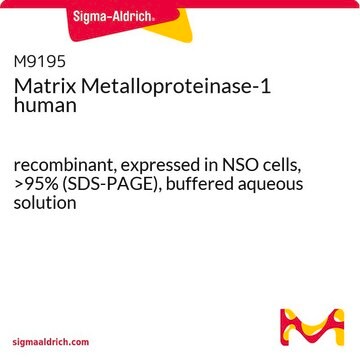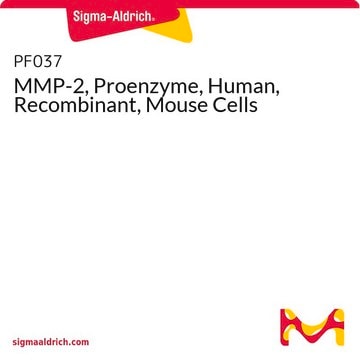M9070
Matrix Metalloproteinase-2 human
>90% (SDS-PAGE), recombinant, expressed in NSO cells, lyophilized powder
Synonym(s):
72 Kd Gelatinase, 72 Kd Type IV Collagenase, Gelatinase A, MMP-2
Sign Into View Organizational & Contract Pricing
All Photos(1)
About This Item
Recommended Products
recombinant
expressed in NSO cells
Quality Level
Assay
>90% (SDS-PAGE)
form
lyophilized powder
mol wt
apparent mol wt ~69 kDa
UniProt accession no.
storage temp.
−20°C
Gene Information
human ... MMP2(4313)
General description
Matrix metalloproteinase-2 (MMP-2) also known as gelatinase or type IV collagenase is a 72kDa protein. MMP-2 is a member of matrix metalloproteinase (MMP) family of enzymes. Basic structure of MMP2 contains signal peptide domain that targets the enzyme for secretion, the pro-peptide domain, which is removed when the enzyme is activated and the catalytic site containing gelatin-binding domain.
Specificity
MMP-2 specifically cleaves type IV collagen, a major structural component of basement membranes.
Application
Matrix metalloproteinase-2 (MMP2) human has been used:
- As a standard in zymography to measure gelatinolytic activity of MMP2.
- In enzymatic method for dissociation of brain tissue to single cells.
Biochem/physiol Actions
Matrix metalloproteinase-2 (MMP-2) cleaves gelatin, type IV, V, VII, X, and XI collagens, fibronectin, elastin, laminin, proteoglycans, and a range of non extracellular matrix (ECM ) components. MMP-2 cleaves native type I collagen to N-terminal ¾ and C-terminal ¼ fragments identical to those generated by interstitial collagenases. MMP2 and MMP9 play an essential role in matrix degradation and they are implicated in the maintenance of neovascularization. MMP-2 activity is associated with human ovarian follicular development. MMP2 expression is elevated in human myocardial infarction and dilated cardiomyopathy. Wound fluid from chronic leg ulcers show elevated expression of MMP2. Overexpression of active MMP2 affects wound healing in chronic leg ulcers. MMP2 activity is inhibited by tissue inhibitor of metalloproteinase-2 (TIMP-2). Human follicular fluid MMP-2 level acts as a potential biomarker of oocyte maturation in in vitro fertilization and intracytoplasmic sperm injection (ICSI) cycles.
MMP-2 degrades general matrix components and may have a role in processes such as host defense, cell proliferation, and protein turnover as well as tissue remodeling.
Physical form
Lyophilized from a 0.2 μm filtered solution of 50 mM Tris, 5 mM CaCl2, 150 mM NaCl, and 1 μM ZnCl2, pH 7.5.
Reconstitution
It is recommended that 0.1 mL of buffer (100 mM Tris, 10 mM calcium chloride, 150 mM sodium chloride, and 0.05% Brij® L23, pH 8.0) be used to give a stock solution of the enzyme at 100 μg/mL.
Analysis Note
The biological activity is measured by its ability to cleave a fluorogenic peptide substrate.
Legal Information
Brij is a registered trademark of Croda International PLC
Storage Class Code
10 - Combustible liquids
WGK
WGK 3
Flash Point(F)
Not applicable
Flash Point(C)
Not applicable
Personal Protective Equipment
dust mask type N95 (US), Eyeshields, Gloves
Certificates of Analysis (COA)
Search for Certificates of Analysis (COA) by entering the products Lot/Batch Number. Lot and Batch Numbers can be found on a product’s label following the words ‘Lot’ or ‘Batch’.
Already Own This Product?
Find documentation for the products that you have recently purchased in the Document Library.
Customers Also Viewed
Matrix metalloproteinase 2 level in human follicular fluid is a reliable marker of human oocyte maturation in in vitro fertilization and intracytoplasmic sperm injection cycles.
Yang WJ
Reproductive Biology and Endocrinology, 13:102 (2015)
Immunohistochemical expression of MMP-14 and MMP-2, and MMP-2 activity during human ovarian follicular development.
Vos MC
Reproductive Biology and Endocrinology, 12:12 (2014)
A non-aggressive, highly efficient, enzymatic method for dissociation of human brain-tumors and brain-tissues to viable single-cells.
Volovitz I
BMC Neuroscience, 17(1):30 (2016)
Thrombospondin-1 suppresses spontaneous tumor growth and inhibits activation of matrix metalloproteinase-9 and mobilization of vascular endothelial growth factor.
Rodriguez-Manzaneque JC
Proceedings of the National Academy of Sciences of the USA, 98(22), 12485-12490 (2001)
Matrix metalloproteinases and myocardial infarction
Phatharajaree W
The Canadian Journal of Cardiology, 23(9), 727-733 (2007)
Our team of scientists has experience in all areas of research including Life Science, Material Science, Chemical Synthesis, Chromatography, Analytical and many others.
Contact Technical Service









